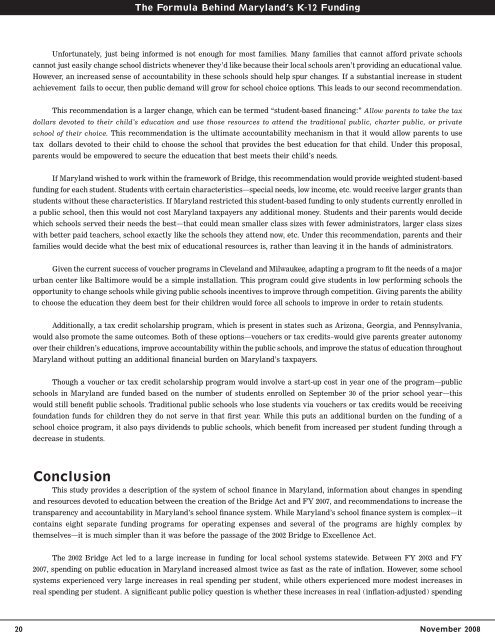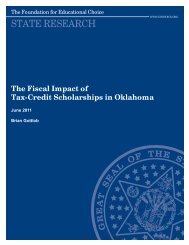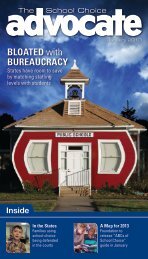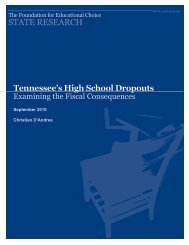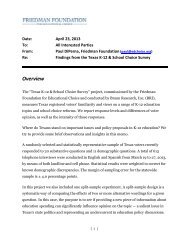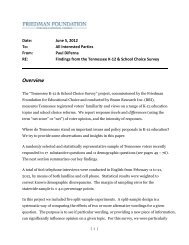View PDF - The Friedman Foundation For Educational Choice
View PDF - The Friedman Foundation For Educational Choice
View PDF - The Friedman Foundation For Educational Choice
Create successful ePaper yourself
Turn your PDF publications into a flip-book with our unique Google optimized e-Paper software.
<strong>The</strong> <strong>For</strong>mula Behind Maryland’s K-12 Funding<br />
Unfortunately, just being informed is not enough for most families. Many families that cannot afford private schools<br />
cannot just easily change school districts whenever they’d like because their local schools aren’t providing an educational value.<br />
However, an increased sense of accountability in these schools should help spur changes. If a substantial increase in student<br />
achievement fails to occur, then public demand will grow for school choice options. This leads to our second recommendation.<br />
This recommendation is a larger change, which can be termed “student-based financing:” Allow parents to take the tax<br />
dollars devoted to their child’s education and use those resources to attend the traditional public, charter public, or private<br />
school of their choice. This recommendation is the ultimate accountability mechanism in that it would allow parents to use<br />
tax dollars devoted to their child to choose the school that provides the best education for that child. Under this proposal,<br />
parents would be empowered to secure the education that best meets their child’s needs.<br />
If Maryland wished to work within the framework of Bridge, this recommendation would provide weighted student-based<br />
funding for each student. Students with certain characteristics—special needs, low income, etc. would receive larger grants than<br />
students without these characteristics. If Maryland restricted this student-based funding to only students currently enrolled in<br />
a public school, then this would not cost Maryland taxpayers any additional money. Students and their parents would decide<br />
which schools served their needs the best—that could mean smaller class sizes with fewer administrators, larger class sizes<br />
with better paid teachers, school exactly like the schools they attend now, etc. Under this recommendation, parents and their<br />
families would decide what the best mix of educational resources is, rather than leaving it in the hands of administrators.<br />
Given the current success of voucher programs in Cleveland and Milwaukee, adapting a program to fit the needs of a major<br />
urban center like Baltimore would be a simple installation. This program could give students in low performing schools the<br />
opportunity to change schools while giving public schools incentives to improve through competition. Giving parents the ability<br />
to choose the education they deem best for their children would force all schools to improve in order to retain students.<br />
Additionally, a tax credit scholarship program, which is present in states such as Arizona, Georgia, and Pennsylvania,<br />
would also promote the same outcomes. Both of these options—vouchers or tax credits–would give parents greater autonomy<br />
over their children’s educations, improve accountability within the public schools, and improve the status of education throughout<br />
Maryland without putting an additional financial burden on Maryland’s taxpayers.<br />
Though a voucher or tax credit scholarship program would involve a start-up cost in year one of the program—public<br />
schools in Maryland are funded based on the number of students enrolled on September 30 of the prior school year—this<br />
would still benefit public schools. Traditional public schools who lose students via vouchers or tax credits would be receiving<br />
foundation funds for children they do not serve in that first year. While this puts an additional burden on the funding of a<br />
school choice program, it also pays dividends to public schools, which benefit from increased per student funding through a<br />
decrease in students.<br />
Conclusion<br />
This study provides a description of the system of school finance in Maryland, information about changes in spending<br />
and resources devoted to education between the creation of the Bridge Act and FY 2007, and recommendations to increase the<br />
transparency and accountability in Maryland’s school finance system. While Maryland’s school finance system is complex—it<br />
contains eight separate funding programs for operating expenses and several of the programs are highly complex by<br />
themselves—it is much simpler than it was before the passage of the 2002 Bridge to Excellence Act.<br />
<strong>The</strong> 2002 Bridge Act led to a large increase in funding for local school systems statewide. Between FY 2003 and FY<br />
2007, spending on public education in Maryland increased almost twice as fast as the rate of inflation. However, some school<br />
systems experienced very large increases in real spending per student, while others experienced more modest increases in<br />
real spending per student. A significant public policy question is whether these increases in real (inflation-adjusted) spending<br />
20 November 2008


